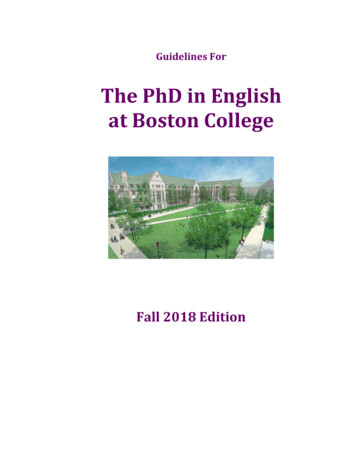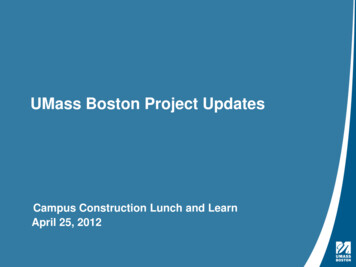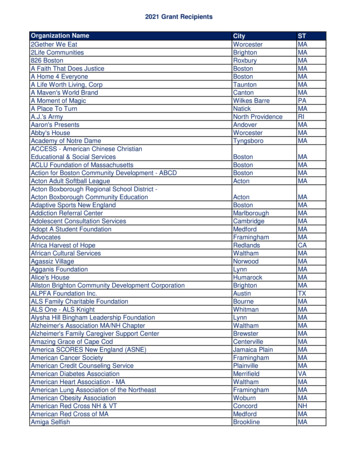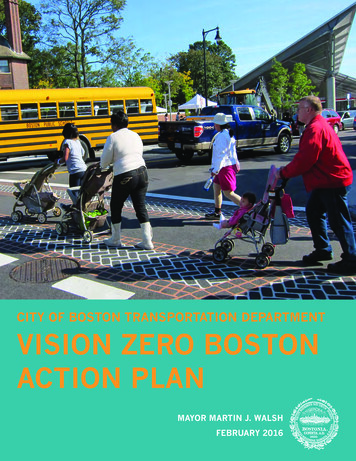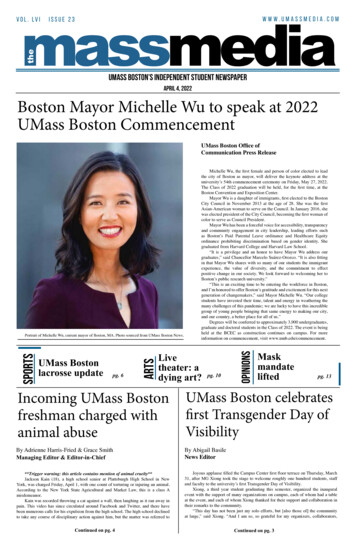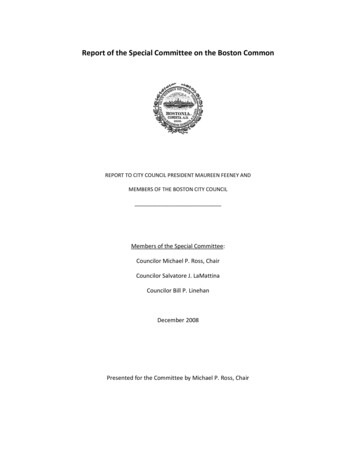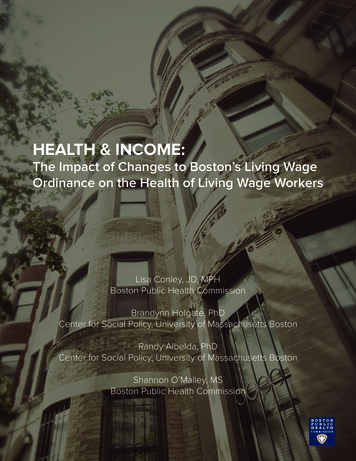
Transcription
HEALTH & INCOME:The Impact of Changes to Boston’s Living WageOrdinance on the Health of Living Wage WorkersLisa Conley, JD, MPHBoston Public Health CommissionBrandynn Holgate, PhDCenter for Social Policy, University of Massachusetts BostonRandy Albelda, PhDCenter for Social Policy, University of Massachusetts BostonShannon O’Malley, MSBoston Public Health Commission
ACKNOWLEDGEMENTS AND DISCLAIMERThis project is supported by a grant from the Health Impact Project, a collaboration of the RobertWood Johnson Foundation and The Pew Charitable Trusts, with funding from the de BeaumontFoundation. The views expressed are those of the authors and do not necessarily reflect theviews of The Pew Charitable Trusts, the Robert Wood Johnson Foundation, or the de BeaumontFoundation. The report also does not reflect the views of the agencies that may have participated in the HIA process, including reviewing drafts of the report and/or providing data for theanalyses in the report. The authors are solely responsible for the accuracy of the statementsand interpretations in this publication. The authors have no involvements or conflicts of interestthat might raise questions of bias in the study results reported.Authors and Contributors:Lisa Conley, Director, Office of Intergovernmental Relations & Policy Development, Boston Public Health CommissionShannon O’Malley, Research Associate, Boston Public Health CommissionMaria Rios, Policy Analyst, Boston Public Health CommissionMakaila Manukyan, Program Coordinator, Boston Public Health CommissionMegan McClaire, Former Chief of Staff, Boston Public Health CommissionAliza Wasserman, Former Policy Analyst, Boston Public Health CommissionRandy Albelda, PhD, Professor of Economics and Senior Research Fellow, Center for SocialPolicy, University of Massachusetts BostonBrandynn Holgate, PhD, Center for Social Policy, University of Massachusetts BostonMichael Carr, PhD. Associate Professor of Economics, University of Massachusetts BostonMichael McCormack, Graduate Research Assistant, University of Massachusetts BostonScott Simon, Undergraduate Intern, University of Massachusetts BostonKim Gilhuly, Human Impact Partners, Project ConsultantKatie Belgard, Political Organizer, 1199 SEIU BostonThe authors wish to acknowledge and thank the following individuals for serving on theAdvisory Board for this HIA project:Randy Albelda, PhD, Professor of Economics and Senior Research Fellow, Center for SocialPolicy, University of Massachusetts – BostonKatie Belgard, Political Organizer, 1199 SEIU BostonLisa Clauson, Former Organizer, UNITE HERE Local 26Alvaro Lima, Director of Research, Boston Redevelopment AuthorityDarlene Lombos, Executive Director, Community Labor UnitedLydia Lowe, Executive Director, Chinese Progressive AssociationHuy Nguyen, MD, Medical Director, Boston Public Health CommissionTrinh Nguyen, Director, Office of Workforce Development, City of BostonSusan Moir, Director, Labor Resource Center, University of Massachusetts BostonMirna Montaño, Organizer, Worker Center, Massachusetts Coalition for Occupational Safety andHealthSteven Snyder, Vice President of Marketing & Development, East Boston Neighborhood HealthCenterBrooke Thomson, Vice President of External Affairs, AT&T New EnglandSpecial thanks also to current and former staff of Boston’s Office of Workforce Development,including Peggy Hinds-Watson, Justin Polk, Constance Martin and Mimi Turchenitz for helping usto understand the complexities of the work they do and for sharing their compliance data withus. We also owe a debt of gratitude to Joyce Linehan for suggesting this topic.Finally, the authors are deeply indebted to the many low-wage workers who joined us as activeparticipants in focus groups and community meetings to share their stories of the challengesthey face trying to stay healthy while working in low-wage jobs. Our only hope is that this reportsheds some light on the struggles they face every day just trying to meet their basic needs.1HEALTH & INCOME: The Impact of Changes to Boston’s Living Wage Ordinance on the Health of Living Wage Workers
TABLE OF CONTENTSEXECUTIVE SUMMARY.page 5SECTION 1.page 11Introduction.page 11Data Sources & Methodology.page 20SECTION 2.page 24Part 1. Existing Conditions.page 24Part 2. Estimated Impacts.page 35Part 3. Public Benefits.page 60Part 4. Impact on Businesses.page 64SECTION 3 Recommendations.page 68SECTION 4 Monitoring.page 69CITED LITERATURE.page 70.APPENDICES.page 73Building a Healthy Boston www.bphc.org2
A LETTER FROM THE MAYORMy Fellow Bostonians,Boston is thriving: our economy is adding jobs, we have a record number of construction starts and we are attracting new businesses to the city. But we know that the city’seconomic success is not shared equally. Unemployment rates among people of colorare high, a quarter of our city’s children grow up in poverty and the average rent in Boston is increasingly unaffordable for many of our residents.As an elected official and a union leader, I have dedicated my career to leveling theplaying field for working people. This continues to be a guiding principle for me as Mayor of the City of Boston.When I took office in 2014, I made it a top priority to examine all of the ways in whichCity government could leverage its authority to improve opportunities for poor andworking people. I am proud to say that in just two years, we have made significant progress toward this goal by changing policy and practice to benefit the working people ofBoston. I signed an executive order to prevent wage theft in Boston, passed a paid family leave ordinance for city employees and enhanced training opportunities for individuals who are reentering the workforce after incarceration. We have worked to close thegender pay gap and committed tens of millions of dollars to increasing the availability ofaffordable housing in Boston.While I am proud of the work we have done, still more lies ahead. I am pleased to beable to present the findings of this report, which helps us understand how we canimprove the city’s Living Wage Ordinance. In addition to identifying opportunities toincrease prosperity among low wage workers, it also makes important connectionsbetween the economic well-being and health of our residents. It shows that when wemake commitments to improving economic opportunities for the city’s most vulnerableresidents, we are also taking steps to improve the health of families.I encourage you to explore the report and to think of other ways that we might improveour residents’ health by enhancing economic well-being.Sincerely,Martin J. WalshMayorCity of Boston3HEALTH & INCOME: The Impact of Changes to Boston’s Living Wage Ordinance on the Health of Living Wage Workers
A LETTER FROM THE EXECUTIVE DIRECTORIn the field of public health, we have long understood that health outcomes are affectedby many factors unrelated to health care access and quality. While clinical health careservices are important, access to quality education, housing and transportation playas critical a role in our ability to maintain healthy communities. Boston has world-renowned hospitals, award-winning doctors and a rich network of community healthcenters. Despite these tremendous health assets, we still face longstanding inequitiesbetween the health enjoyed by many White residents and those of Black and Latinoresidents in the city.Boston is facing unprecedented levels of economic inequality and this inequality is affecting the health of our children, families and communities. Almost a third of childrenin Boston live in poverty, but this burden is not evenly distributed. While predominantlyWhite neighborhoods have low rates of child poverty, neighborhoods of color, suchas Roxbury and North Dorchester, have poverty rates well above the city average. Asdescribed in detail in this Health Impact Assessment, low-income families struggle tofind resources to pay for basic necessities, including quality housing, healthy foods andmedicines.In keeping with Mayor Walsh’s Economic Inclusion and Equity Agenda, we must look foropportunities to increase access to good paying jobs for all Boston residents. It is myhope that this Health Impact Assessment contributes to this goal and that it sheds lighton the many challenges that low-wage workers face as they try to maintain their healthin today’s economy.Monica Valdes Lupi, JD, MPHExecutive DirectorBoston Public Health CommissionBuilding a Healthy Boston www.bphc.org4
EXECUTIVE SUMMARYBy many measures, the City of Boston is a great place to live and ranks at or near thetop of many “best of” cities lists. The Hub is among the most walkable cities in the US,[1]holds title to the best-tasting tap water,[2] and tops the list of cities with the best accessto healthcare. Boston is one of the best cities for love according to Zillow,[3] the thirdbest city for people who enjoy sports[4] and the best place in the country to go to college.[5] At the same time, Boston also ranks in the top 10 of cities that are least affordable in terms of housing and number one on the list of the most unequal cities in thenation[6]. The qualities that make Boston a desirable place to live are also contributingto a population surge that is driving up the cost of living in the city. Indeed, between2010 and 2014, the Greater Boston area, which includes both the city of Boston andcities and towns just outside of Boston, added 67,000 new households but only 15,000housing units.[7] The average rent in Boston is now over 2,000 per month, putting itjust behind New York, San Francisco and the Silicon Valley as among the nation’s mostexpensive places to rent an apartment.[8]The steep rise in costs and stagnant real median income[9] means that Boston is quicklybecoming a city of haves and have-nots. Economic inequality in Boston breaks downstarkly along racial and ethnic lines and is borne out in a number of ways – throughunequal access to employment opportunities, housing and transportation. Of the city’sapproximately 617,594 residents, 24.4% are Black and 18% are Latino.[10] Poverty ratesfor Boston’s residents of color are higher than that of White residents. Black, Latino andAsian residents in Boston have poverty rates of 23%, 34.8% and 26.6%, respectively.[9]Unemployment among Black and Latino men is perennially higher when compared5HEALTH & INCOME: The Impact of Changes to Boston’s Living Wage Ordinance on the Health of Living Wage Workers
with the rest of Boston; in 2014, the unemployment rate in Boston was as low as 8%,but the unemployment rate among Latino men was 1.5 times the city average andunemployment among Black men was 1.75 times the city average.[11] Boston’s medianfamily income is 63,058 per year, but Black families on average make only 43,902and Latino families 32,372 per year.[12] In addition, Black and Latino residents in Bostonmake up 59% of the city’s residents who are living at or below the poverty line.[13] Andthe trend is not getting better; household income inequality has grown in Boston overthe past thirty years. According to analysis from the Boston Redevelopment Authority,the number of Boston households making over 150,000 has grown - from 3.1% in 1980to 13% in 2013 - while middle class income has fallen.[9]Mayor Martin J. Walsh, who took office in January 2014, has deep roots in the labormovement and a strong commitment to social equity. As the new administration assumed office, Mayor Walsh initiated a review of the city’s labor practices, includingsettling long-overdue collective bargaining agreements with city unions, proposing apaid parental leave ordinance for exempt city workers, issuing an Executive Order toprevent wage theft and revitalizing and rebranding the city’s Office of Jobs and Community Services, now the Office of Workforce Development. As part of this process,the Administration committed to a review of the effectiveness of the city’s Living WageOrdinance, which was enacted in 1997 and went into effect in 1998.Building a Healthy Boston www.bphc.org6
HEALTH IMPACT ASSESSMENTThis Health Impact Assessment (HIA) examines the impact of Boston’s Living WageOrdinance (LWO) on the health of those currently covered and asks what changescould be made to maximize improvements in health. Specifically, the analysis focuseson the health impacts that could be anticipated with an increase in the living wage fromits current level of approximately 14 per hour to approximately 17 per hour. Due todata and resource limitations, we were unable to provide predictions of outcomes onother recommendations. However, we make additional policy recommendations in thisHIA that are based on our extensive analysis of the published literature, existing data,stakeholder input, and the experience of living wage implementation in other cities.An HIA is a systematic process that examines published research, data, stakeholderinput and other sources of information to draw conclusions about how a proposedpolicy, program or plan will impact the health of populations with a focus on increasingequity and inserting health considerations into the decision-making process. HIAsfollow six distinct steps: screening, scoping, assessment, recommendations, reportingand monitoring.As depicted below, we examined the relationship between income and health with afocus on outcomes related to diet-related chronic disease, stress and access to qualityhousing.7HEALTH & INCOME: The Impact of Changes to Boston’s Living Wage Ordinance on the Health of Living Wage Workers
BACKGROUNDAlmost 20 years ago, labor advocates, community activists and faith leaders organizedto pass Boston’s LWO. Approved in 1997, Boston’s ordinance was one of the first inthe country, and in the ensuing years and decades over 140 other local governmentsfollowed the lead in adopting living wage policies. At least 20 percent of the total USpopulation and 40 percent of residents in large cities live in an area covered by a localliving wage policy.[14] Like other municipalities, the goal in Boston was to ensure that cityresources were used in a way that would promote the financial well-being of workerswho were employed under city contracts, particularly at a time when some good-paying city jobs were privatized and paid at a lower wage.In the years that followed implementation of the LWO, the percentage of workersmaking less than the living wage in covered businesses in Boston fell from 25 percent to less than 5 percent, with no such changes seen in a non-covered comparisongroup of employers.[14] As importantly, covered businesses did not cut jobs or hours asa result of the LWO, and contracting costs actually decreased.[14] A 2005 study foundthat most living wage workers were adults who were well into their careers. A surveyof these workers concluded that Boston workers experienced “small but concrete”improvements to their quality of life as a result of implementation of the LWO.[14] Despitethis, it was “not enough to lift affected workers to a higher standard of living that betterreflects the spirit and intent of the ordinance.”[14]The current state of the LWO is unchanged from the analysis in the mid-2000s: theordinance continues to produce a modest improvement in the economic standing ofcovered low-wage workers. However, as the cost of living rises in Boston, the livingwage as currently defined in the ordinance is not enough to afford basic necessitiessuch as food, housing, transportation and childcare, and the gap between the livingwage and a family-sustaining wage in Boston is growing. What’s more is that the LWOas currently written applies to only about 1,900 individuals, of which only about 600 arelow-wage, which limits its overall impact.Building a Healthy Boston www.bphc.org8
POLICY OPTIONSProposals Under Consideration Increase Living Wage to better approach or equal family-sustaining wage Expand scope of LWO to cover additional workers Improve enforcement of LWO and invest in enhanced data collectionKEY FINDINGS The Living Wage (LW), currently pegged at 14.11/hour, is insufficient to sustain a family in Boston. Based on 2013 data, each working adult in a two-parent family, working full-time would need to earn at least 16.96/hour each to afford basic needs offood, housing, transportation and childcare. The LWO covers only about 600 individuals at the bottom of the wage scale, whichlimits its impact on low wage workers. Of these individuals, we estimate that almosthalf are people of color. 21% of covered workers are Boston residents and 47% are women. 28% of coveredworkers workers have children, while 51% are married without children. Most workers on city contracts that are affected by the LWO are providing vitalsocial and human services to vulnerable populations in the city, including homelessindividuals, elders and children. Income is strongly linked to food access and diet-related chronic disease. An increase in the wage to equal a family-sustaining wage for low-wage covered workers would yield almost a 30% drop in hunger and food insecurity and a 43% drop indiabetes. Increases in income are also strongly associated with mental health outcomes.Increasing the wage for low-wage covered workers would result in a 62% drop inpersistent sadness and a 30% decrease in anxiety. Hypertension would drop by10%.Health OutcomeIncrease/Decrease in thePercent of CasesPersistent Sadness-61.9%Persistent Anxiety-29.8%Consuming Fruit at least Once a Day5.3%Consuming Vegetables at least Once a Day2.0%Hypertension-9.5%Diabetes-43.4%Adult Asthma-11.0%Food Insecurity-28.0%Hunger-28.0%RECOMMENDATIONSAlmost twenty years into implementation, Boston’s LWO has yet to live up to its full potential to improve the health and well-being of low-wage workers. We recommend thatthe city update the LWO in the following ways: Alter the way that the Living Wage is calculated to ensure that it is equal to a familysustaining wage in Boston. This would enable more individuals who are working inliving wage firms to afford their families’ basic needs, such as housing, transporta9HEALTH & INCOME: The Impact of Changes to Boston’s Living Wage Ordinance on the Health of Living Wage Workers
tion, childcare and food.Expand the LWO to cover entities and workers that are not currently covered. Forexample, the city should cover quasi-independent city agencies, businesses thathold large leases with the city, businesses that benefit from tax credits and thosethat receive city-subsidized financing. The city should also ensure that the LWOcovers all city employees.Collect better data on employees who are covered by the LWO. This will enablethe city, advocates and others to better understand who is currently working underthe Living Wage and to tailor services to this population of vulnerable workers. Itwill also enable the city to document its successes.Building a Healthy Boston www.bphc.org10
SECTION I: INTRODUCTION“Income inequality” is a phrase oft-heard on the lips of politicians, pundits andacademics. It has become shorthand for the ever-expanding economic dividethat separates the poorest people in society from the richest ones. It is a gapthat is growing, leading President Obama in 2013 to declare it “the definingchallenge of our time,” and one that “poses a fundamental threat to the American Dream.”[15] According to a study by the Pew Research Center, the UnitedStates ranks fourth among all nations in income inequality and first amongdeveloped nations.[16] In this context, it is not surprising that almost 7 in 10 Americans say that the income divide is growing and that they are dissatisfied withtheir income and their opportunities to get ahead.[17] The most recent analysis bythe Brookings Institution pegged Boston as the most unequal city in the UnitedStates. Among cities in the US with a population of 500,000 residents or greater, Boston has the largest gap between rich and poor – higher than other welloff cities such as New York City and Washington, DC.Arriving in office in January 2014, Mayor Martin J. Walsh has made addressingincome inequality a signature issue of his administration. A son of Irish immigrant parents and longtime union laborer, Mayor Walsh rose through the ranksof the Laborers Local 223 and later became an administrator for the BuildingTrades Council. He was elected as a state representative from Dorchester forthe 13th Suffolk District in 1997 and served in the House of Representativesuntil he became Mayor in 2014. During the mayoral transition, then-Mayor-ElectWalsh’s Economic Development Transition Team recommended that the administration undertake “an examination of the current impact and enforcement ofthe Living Wage ordinance and [assess] the feasibility of its expansion to ensurethat all residents have access to good jobs that allow them to provide for theirloved ones.”[18] According to the transition document, the city should look to expand the ordinance to cover employees of businesses receiving city subsidiesand employees of subcontractors and tenants, and strengthen enforcement forthose already covered.In his inauguration speech, the Mayor spoke to the problem of inequality inBoston, saying “we cannot tolerate a city divided by privilege and poverty.”[19]Since taking office in 2014, Mayor Walsh has pursued policy changes that are inline with his goal to ease the strain on low income, working poor individuals andfamilies in Boston. This focus has included a commitment to reviewing the city’scurrent wage and labor policies to evaluate their impact and strengthen theireffectiveness.Among the policies under review is the City of Boston’s Living Wage Ordinance(LWO). The LWO, passed in 1997, requires contractors who hold service contracts with the city to pay a living wage to employees covered by those contracts. As part of this review and updating process, Mayor Walsh has alreadytaken steps with support of City Council to pass amendments to the LivingWage Advisory Committee and has appointed new members to the Committeein an effort to reinvigorate this advisory body. The Mayor’s Office of Workforce11HEALTH & INCOME: The Impact of Changes to Boston’s Living Wage Ordinance on the Health of Living Wage Workers
Development (OWD), which bears primary responsibility for enforcement of theLWO, has undertaken a thorough review of its enforcement system and identified opportunities to enhance enforcement activities. This review has led to thehiring of additional enforcement staff, a new system of conducting payroll auditsof covered employers and a thorough audit of compliance mechanisms.There is also an interest in understanding the historic impact of the LWO on lowwage workers and whether there are areas that could be improved to maximizethe impact. This Health Impact Assessment (HIA) report is part of this reviewprocess and will provide recommendations and an analysis of the impact ofpotential changes on the health of Boston residents. This report shows howhigher household income relates to better average health outcomes and thenlooks more closely at how an increase in the LW might impact health outcomesfor Boston’s LW workers.The proposed policy changes are expected to have the greatest impact on lowwage workers with jobs in Boston (residents and non-residents), as well as thebusinesses that employ them. As noted above, Boston continues to experiencelarge inequities in the distribution of wealth, employment and health status. Ofthe city’s approximately 618,000 residents, 24.4% are Black and 18% are LatiBuilding a Healthy Boston www.bphc.org12
no, but they do not share equally in the prosperity enjoyed by white Bostonresidents. [10] Boston’s median family income is just under 50,000 per year,but Black families make only 42,902 per year and Latino families 32,372 peryear. During 2012, White residents had a poverty rate of 15% while the povertyrate for Asian, Black and Latino residents was higher (26.6%, 23% and 34.8%respectively).[20]One in 4 children lives in poverty in Boston. Forty percent of workers in Bostonare in low wage jobs, and the majority of low wage workers are people of color,particularly Black and Latino residents. Although Boston has recovered all ofthe jobs lost during the Great Recession, 85% of the jobs added between 2009and 2014 were low-paying, meaning that they have annual salaries of less than 38,000 per year.[21] The fields that accounted for the most gains in job growthwere in the traditionally low-paying sectors of food service, janitorial services,and home health care.[22]Nationwide, Black and Latino workers are disproportionately represented inthe lowest-paying occupations. In 2014, 25% and 26% of employed Black andLatino workers, respectively, were in a service occupation, compared to 16%of White workers. Blacks and Latinos were also less likely to be employed inthe higher-paying management, professional, and related occupations: 39%of employed Whites had jobs in this category compared to 30% of Black and21% Latino workers. Labor statistics also reveal that White men out earn Blackand Hispanic men across nearly all major occupational groups, as well as at alllevels of educational attainment.[23]When stagnant or declining wages are coupled with the described increases incosts of living, we can expect to see increased poverty among working families.Among households living in poverty in Boston, 15% had at least two workingadults in 2013, up from less than 10% in 2008.[21] Nationally, Blacks and Latinoswere more than twice as likely to be working poor (defined as having workedfor at least 27 weeks during the year but with incomes below the poverty level)than Whites were in 2013. The working poor rate for Whites was 6.1% comparedto 13.3% for Blacks and 12.8% for Latinos.[24]13HEALTH & INCOME: The Impact of Changes to Boston’s Living Wage Ordinance on the Health of Living Wage Workers
A 2015 report by the Federal Reserve Bank of Boston, “The Color of Wealth inBoston,” highlights the stark income and wealth differences between White andNon-White residents of Boston’s Metropolitan Statistical Area (MSA). Net worth,the sum of the value of total assets minus the value of debts, provides a snapshot of household financial well-being. Striking racial differences are evidentwhen looking at total household wealth. Non-White households have only afraction of the wealth of white households. Whereas White households have amedian wealth of 247,500, Dominicans and U.S. Blacks have a median wealthof close to zero. Of all Non-White groups for which estimates could be made,Caribbean Black households had the highest median wealth with 12,000,which represents only 5 percent as much wealth as White households (seeFigure 1).[25]Racial and ethnic differences in net worth demonstrate the extreme financialvulnerability faced by people of color in Boston. Possessing less than 5 percent of the wealth of White households, people of color are less likely to havethe financial resources to draw upon in times of financial stress. In addition, theyhave fewer resources to invest in their own future and those of their children.Racial differences in asset ownership, particularly homeownership, contribute tovast racial disparities in net worth. Homes—the most valuable asset owned bymiddle-class households—comprise the bulk of middle-class wealth. However,unequal opportunities (past and present) to build other assets and to reducedebt are contributors to the vast racial wealth gap substantiated in this analysis.Figure 1. Comparison of Household Median Net Worth By Race/Ethnicity inThe Boston MSA*Source: Muñoz et al. 2015. National Asset Scorecard for Communities of Color (NASCC) survey.Note: The Boston MSA (Metropolitan Statistical Area) includes the following counties: Essex, Middlesex, Norfolk, Plymouth, and Suffolk in Massachusetts; and Rockingham and Strafford New Hampshire.Note: The Boston MSA is home to 4.6 million residents and accounts for almost one third of New England’s population(2012 American Community Survey 1-year estimates).The HIA will assess the potential health impacts on all of those affected in addition to the important subset of the city’s Black and Latino residents.Building a Healthy Boston www.bphc.org14
POLICY PROPOSALSAs the LWO approaches its 20-year anniversary, the ordinance is ripe for review. While it is clear from the evidence that the ordinance has brought improvement for a small number of workers who were previously making lowerwages, there is little doubt that it has yet to live up to the lofty principles thataccompanied the policy when it first passed. The poverty-level standard inthe ordinance remains well-below Boston’s cost of living and there are too fewworkers covered by the ordinance to have a real impact on the experience ofmost low-wage earners in Boston.At the outset, the Research Team identified a number of areas where the citycould consider changes to the ordinance that could
Brandynn Holgate, PhD, Center for Social Policy, University of Massachusetts Boston Michael Carr, PhD. Associate Professor of Economics, University of Massachusetts Boston Michael McCormack, Graduate Research Assistant, University of Massachusetts Boston Scott Simon, Undergraduate Intern, University of Massachusetts Boston



